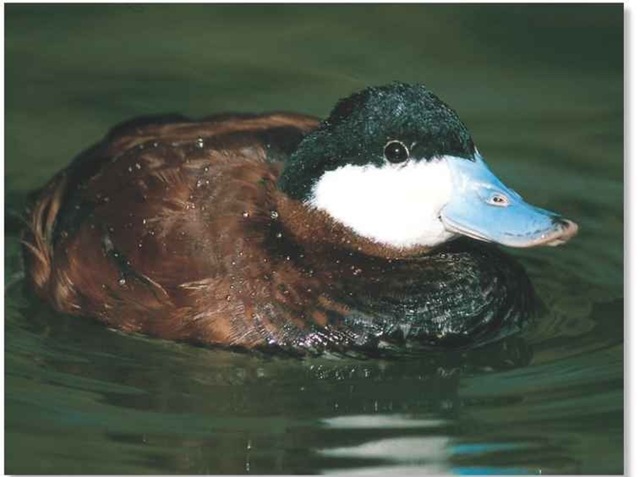ORDER
Anseriformes
FAMILY
Anatidae
GENUS & SPECIES
KEY FEATURES
• Feeds by swimming along the bottom of lakes and pools while straining silt with its bill
• A skilled diver that can sink beneath the water surface like a stone and rise again like a cork
• During breeding season, males are aggressive and fight with bill and body for territories
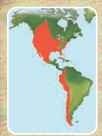
WHERE IN THE WORLD:
One race occurs in much of North America; two other races are found along the coastal strip of western South America; introduced to Britain in the 1950s and spread to mainland Europe
Lifecycle
Although shy and secretive, especially during the breeding season, this North American duck has become an increasingly common sight in many wetlands and estuaries.
Habitat
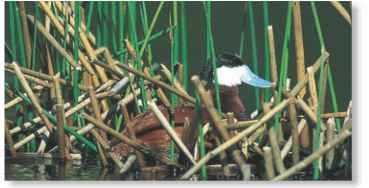
A Home sweet home Thick reeds provide the duck with a safe refuge.
Being a specialized swimmer and diver, the ruddy duck’s preferred habitats are marshes or shallow, freshwater lakes and
ponds that are rich in floating and submerged aquatic plants. When nesting with a mate or brooding young, the ruddy duck prefers to skulk among thick vegetation and away from the shore. It avoids turbulent or flowing waters and exposed, rocky pools.
Every year, following the spring-summer breeding season, ruddy ducks in cool northern climates gather in large groups to migrate south for the winter. In Canada and the U.S., these groups can be many thousands strong. Migratory journeys of over 900 miles are not uncommon. The ruddy duck typically overwinters in large congregations on inland lakes, although it also makes use of the salt waters around estuary mouths and in sheltered coastal bays.
conservation
The ruddy duck’s populations in Canada and the U.S. are stable. The species has adapted so readily to conditions in Europe that it-now poses a threat to the closely related white-headed duck (Oxyura leucocephala) — an endangered species native to Spain — that may eventually become extinct if it continues to breed with the ruddy duck. At present, ruddy ducks are separated from the other breed in Spain.
Behavior
Except when migrating, the ruddy duck seldom flies. When it does, it takes off with difficulty, keeps to a low altitude and skates across the water to an awkward stop when landing.
Drakes fight to defend territories, nipping and wrestling one another above and below water. If provoked, females are also aggressive, adopting a threat posture: body hunched, head thrust out, bill agape. If disturbed by a predator, the ruddy duck dives to escape.
Up, up and away
Ruddy ducks need a long runway to get airborne.
Breeding
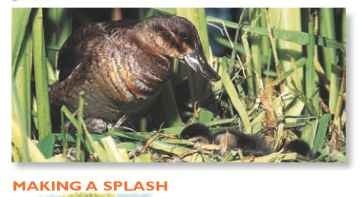
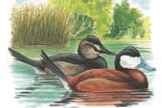
If at first…
The drake puffs up his chest and shows his tail feathers. Unimpressed, the female may even be hostile.

You don’t succeed…
The drake paddles furiously with his tail submerged, chest lifted out of the water and bill tucked in.

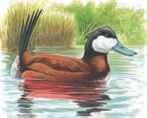
And try again!
Finally won over, the female follows the drake, who cocks his tail to expose his bold white rump feathers.
Try, try…
The drake repeatedly thumps his bill against his puffed-up chest and blows clouds of bubbles.
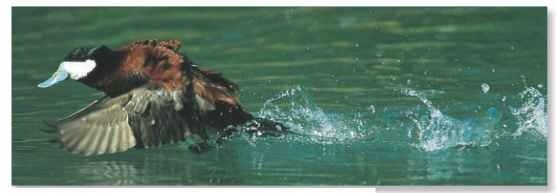
Ruddy ducks colonized Europe after escaping from an English wildfowl collection.
They have nearly 100 colloquial names, including hickory-head and rubberneck.
In early spring, both sexes molt their winter plumage, ready for breeding. A female’s new coat is reddish-brown; the drake sports rusty-red plumage with glossy black crown and white cheeks.
The drake may spend several hours performing ively displays to impress a potential mate. During this courtship, he patrols her immediate area, shooing away any rival suitors.
After mating, the pair finds a concealed site among reedbeds, 200′ or so from dry land and about 100′ from open water Here, the female builds her nest, using dead reeds and rushes. She alone incubates the clutch. The drake often stays close by until the eggs hatch, but he may mate with other females if opportunities arise.
The ducklings are highly active; by the time they can fly, at 6 weeks or so, they are already independent.
Food & feeding
During winter, the ruddy duck lives primarily on a vegetarian diet. It grazes on pondweeds and sedges as well as seeds, which it filters from mud on the pond floor. During the summer, it supplements its diet with freshwater snails and larvae of midges and other insects. Ruddy ducks also feed on small shellfish when in estuarine waters.
To feed, the ruddy duck dives and swims along the bottom, neck extended and head moving from side to side, its bill half-immersed in the mud. Food is filtered from the mud through serrations along edges of the bill. The ruddy duck may also skim and filter food from the water’s surface, moving its head side to side while keeping its bill half-immersed.
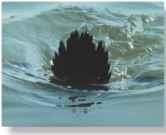
A Deep breath Ruddy ducks cai dive and stay under for almost half a minute.
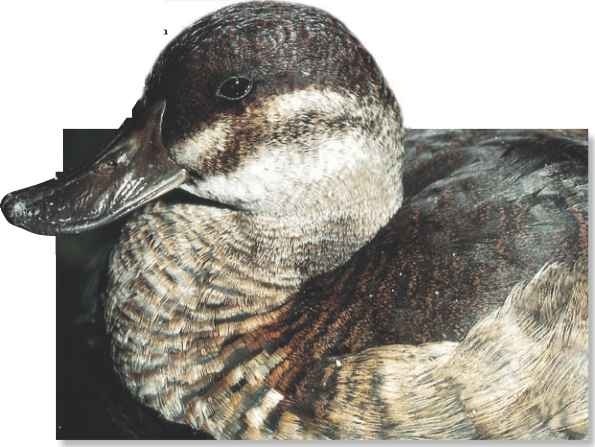
Profile
RUDDY DUCK
The ruddy duck’s strong legs, waterproof plumage and stocky, naturally buoyant body enable it to swim and dive with masterful ease.
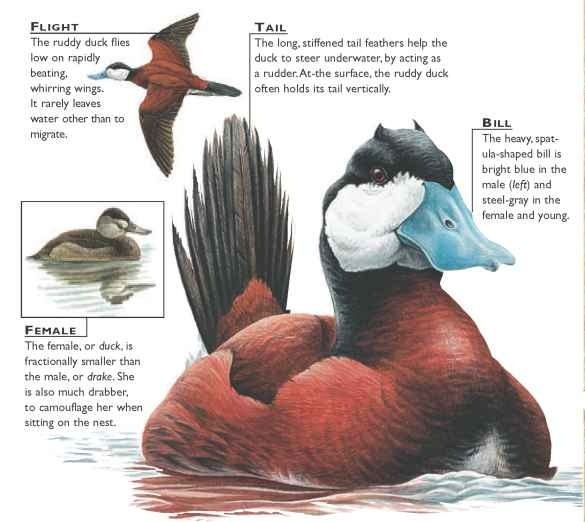
Creature comparisons
The teal family includes many of the world’s smallest ducks. The green-winged teal (Anas crecca), one of the most abundant and widespread teals, is smaller than the ruddy duck, with shorter tail feathers.The teal belongs to the tribe known as surface-feeding, or dabbling, ducks.The ruddy duck belongs to stiff-tailed, diving ducks. Bill shape is the most important difference between these species. Green-winged teal’s slender, flattened bill is adapted to grazing and nibbling plants along the water surface. Ruddy duck’s broad, saw-edged bill filters insects and seeds from the muddy bottom.

Ruddy duck (male)

Green-winged teal (male)
| VITAL STATISTICS | |
| Weight | Male 19-28 oz.; female 10.5-23 oz. |
| Length | 14-17″ |
| Wingspan | 21-25″ |
| Sexual Maturity | 1-2 years |
| Breeding -: Season | Spring in North America and Europe; all year-round in South America |
| Number of Eggs | 6-14 |
| Incubation Period | 25-26 days |
| Fledging Period | 50-55 days |
| Typical Diet | Insects, seeds and leaves of aquatic plants |
| Lifespan | About 8 years |
RELATED SPECIES
• The ruddy duck is 1 of 8 species in the stifftail tribe, Oxyurini. Stifftails are among 140 or so species in order Anseriformes, ‘including pintail, Anas 1
• acuta (below). Anseriforms, .which also include swans and geese, have short, strong legs, webbed feet and oily plumage.

